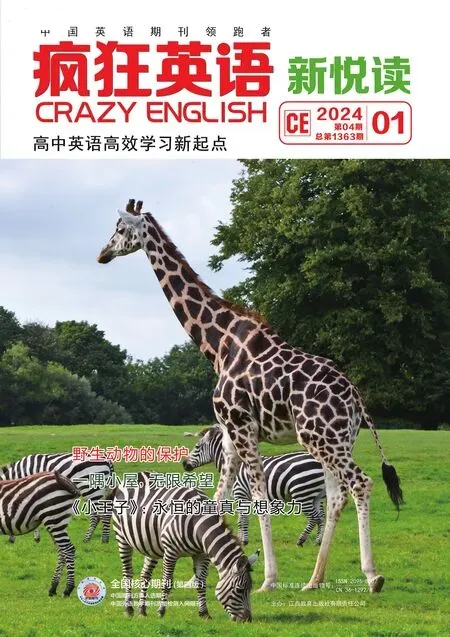Save the Ili pika
浙江 江 丽
因为伊犁鼠兔,李维东的人生道路发生了变化,他从卫生系统离开,进入新疆环境保护科学研究所,全身心投入野生动物保护事业中。

主题语境:保护伊犁鼠兔 篇幅:349词 建议用时:7分钟
1It's been 40 years since Li Weidong,68,a wildlife protection expert,accidentally dis‑covered the Ili pika (伊犁鼠兔) in the Tianshan Mountains.Looking back, he's filled with emotion.“I discovered the endangered species.If I don't protect it and it becomes extinct,I'll be the one to blame,”he says.
2The Ili pika is a small, fluffy (覆有绒毛的)mammal, around 20 centimeters long, with bright fur,big round ears and brown mottled (杂色的) fur on its forehead and neck.It impresses people with its beauty and cuteness.It looks like a cross between a rabbit and a mouse, but actually belongs to the lagomorpha(兔类) order.Among the world's 24 pika species, it has the largest ears, longest hind feet and largest body size.It's regularly found near the bare rocks located between 2800 and 4100 meters above sea level in the Tianshan Mountains.It lives alone,doesn't drink water,but eats rare alpine plants.
3When the Ili pika was formally recognized as a new species in 1986, Li estimated that its number was around 3000.However, when Li traveled around the area in 2002, he became worried that the species had lost half of its habitat.Since then, he has systemati‑cally investigated the population of the Ili pika every four years, mainly by tracking its footprints and monitoring its food storage.

4Li never gives up, and in his late 60s, he continues his journeys through the isolated land, at an altitude of up to 6000 meters, to seek the Ili pika with his wife.Falling over meant severe injury as they both personally experienced,yet the couple insisted on going to capture an image of an Ili pika.
5Now, 71 percent of the Ili pika's habitat has disappeared, which means there might currently be less than 1000 Ili pikas in the wild.Global warming has led to the species moving up to higher altitudes.Some have made their way to the top of the peak.“The Ili pika is extremely sensitive to climate change.The disappearance of the Ili pika indicates the damage and shrinking of our own living environment,”Li said.
Reading Check
1.What does paragraph 2 mainly talk about?
A.How the Ili pika was discovered.
B.The Ili pika's appearance.
C.The Ili pika's habitat.
D.Where the Ili pika comes from.
2.How did Li find out the population of the Ili pika according to paragraph 3?
A.By living in its habitat.
B.By estimating its living environment.
C.By studying its footprints and food storage.
D.By using systematical records.
3.What has contributed to the decline of the Ili pika's habitat?
A.Li Weidong's journeys through the isolated land.
B.Deforestation in the Tianshan Mountains.
C.The Ili pika's sensitivity to water.
D.Global warming.
4.Which word can best describe Li?
A.Generous.B.Cautious.C.Consistent.D.Proud.
Language Study
Ⅰ.日积月累
accidentallyadv.偶然地
blamev.责怪
anxiousadj.焦虑的
seekv.寻找
be recognized as 被认为是
at an altitude of 在海拔……
make one's way to 前往
Ⅱ.语法填空
In the 1980s, it was Li Weidong 1.________discovered and named the Ili pika.Since then, the former public health expert 2.________(turn) his career focus to wildlife protection.As he himself has put it, he“has served 3.________a spokesperson for wild animals”for four decades.
He has joined protection programs for the Ili pika, Tibetan antelopes, wild camels,4.________Mongolian wild asses.And over the years, he has been consulting on, and delivering environmental impact assessments of, major construction 5.________(project)in the region.He's also 6.________lagomorph expert for the International Union for Con‑servation of Nature Species Survival Commission.
The wildlife passages over the G7 Expressway, 7.________(build) on a total cost of more than 200 million yuan, aim 8.________(minimize) humans' influence and guarantee safe passages for the animals.The passages 9.________(cover) with sand and gravel to simulate (模拟) natural conditions.The railway‑wildlife passage‑highway structure is an unprecedented trial in the country.The expert believes the passages have met the 10.________(base)needs of wildlife migration in the area.

